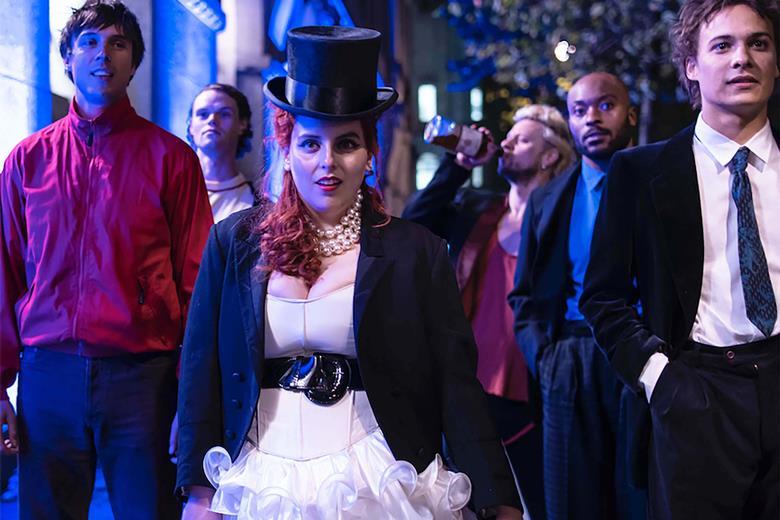You wanted Beanie Feldstein front and center? Well, if you’ve been watching movies for the past few years, you have. And now is your chance to thank the movie gods, because she very much is in How to Build a Girl, and it is glorious. It doesn’t come easy though. Johanna Morrigan may take a less familiar path to coming of age than most teens, but How to Build a Girl captures the emotional roller coaster of impending adulthood in all its exhilarating highs and cringeworthy, at times devastating, lows.
Johanna is an aspiring writer who at 16 is waiting for the kind of moment her heroines have in the books she reads voraciously, even if she can’t find any about a girl like her. In the meantime, she has to dodge the neighborhood bullies and try to make it through school while her large, impoverished family scrapes by as best as they can. She takes her inspiration where she can find it, from various talking posters to the hero wall in her bedroom, which happens to be the source of many a celebrity cameo. And I mean many, since Johanna’s inspirations are as wide-ranging as the Bronte sisters (Sue Perkins and Mel Giedroyc), Elizabeth Taylor (Lily Allen), Karl Marx (Alexei Sayle), Maria von Trapp (Gemma Arterton), Cleopatra (Jameela Jamil), Sylvia Plath (Lucy Punch), Sigmund Freud (Michael Sheen), and of course, the patron saint of any awkward, ambitious girl who’s lived during the past few hundred years, Jo March (Sharon Horgan).
When Johanna sees an ad for a rock critic, she jumps at the chance. Just when you’re asking if every female writer is legally obligated to kiss the first manuscript she mails out, Johanna is in the room at a music magazine and insisting to all the men there that she be taken seriously. Okay, after crying in the bathroom after they treat her like a joke, but THEN she marches back in and gets her shot, even giving herself a cool makeover and becoming Dolly Wilde. For a while, it actually works. As Dolly, Johanna is able to write good articles, see them published, get into shows for free, make out with and eventually have sex with the men of her choosing, and become the breadwinner of her family, she even gets that magical, elusive thing: coolness, both at work and at school.
Being cool doesn’t always mix well with sincerity though, especially when you’re as eager and in love with what you do as Johanna is. This painful reality hits hard when she forms a sweet connection with up-and-coming rock star John Kite, which has the lovely side effect of allowing Alfie Allen to play a heartthrob for once. Convincingly. Even if it’s easy to see how their charming conversation in his hotel room could easily turn exploitative, he sleeps in the bathtub and gives her his bed when she has to spend the night, so Johanna does what any 16-year-old would after experiencing kindness from such a charismatic, talented source – she swoons, then less typically, is rewarded by almost getting fired. So she decides to opt in to the toxicity around her that reaps rewards, kicking off a downward spiral that could end her career before it even really begins.
Since much of Johanna’s story takes place in the music world, it’s not so surprising that much of her coming-of-age follows the familiar beats of a musical biopic, complete with a rise, fall, and subsequent reform. What makes it feel so fresh is that it’s taking place from a less than familiar angle. Movies about wide-eyed writers in a hedonistic music industry may be fewer and far between, but they’re no less familiar. Whatever the genre, they’re rarely, if ever, told from a woman’s perspective, especially from one that’s writing her own story rather than being longingly idealized and objectified from afar. Wish fulfillment through a past that could’ve been is all the rage right now, but Johanna might just be what it looks like for women, complete with snappy comebacks always at the ready for the sexism she encounters at nearly every turn.
There may even be genuine nostalgia for many, and not just for a time when writers could actually get paid for their work. How to Build a Girl isn’t here to make a case for the 90s being a gentler time, since the hipster bros at the music magazine Johanna works at could easily be the forerunners for the guys complaining online about PC culture and social justice warriors. Hell, they probably are those guys. No, the real longing is for the freedom to screw up as spectacularly and painfully as Johanna does without it being broadcast to the world, even if her low feels so arbitrary, it comes off more as spiteful punishment on the part of Caitlin Moran, who adapted the screenplay from her autobiographical novel.
That’s mostly the exception, as much of the time How to Build A Girl keeps its humor, even under the darkest of circumstances. Then of course, there’s the charm and skill of Beanie Feldstein herself, who at 26 is too old to be playing teens and whose accent is tenuous at times, but nevertheless effortlessly carries the show as she was meant to rather than stealing it from the sidelines. It might devolve a little too much into a writer’s version of a fairy tale, but How to Build a Girl does successfully repurpose the kind of epic journey that’s previously been the sole province of men. Or as Johanna puts it, “Like all the best quests, you did it all for a girl. You.”
Advertisement
Advertisement
